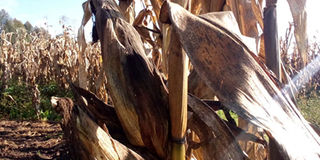Nyandarua farmers count losses as rains wreak havoc

Maize ready for harvest which is rotting in a farm in Nyandarua due to the ongoing heavy rains. The situation is posing a food security threat in one of the country’s food baskets. PHOTO | WAIKWA MAINA | NATION MEDIA GROUP
What you need to know:
- Maize is currently grown in about 16,906 hectares with an average annual production of 37,184 tons.
- Destruction of maize by the rains is likely to worsen the food crisis in the country.
- By December, Nyandarua had a monthly deficit of 29,297 bags needed to feed its population.
gNyandarua farmers are staring at huge losses caused by the ongoing rains, posing a food security threat in one of the country’s food baskets.
The most affected crop is maize which is ripe for harvest and is now rotting on farms.
Maize farming is the second most important agricultural activity in the region after growing of Irish potatoes.
Maize is currently grown in about 16,906 hectares with an average annual production of 37,184 tons valued at Sh1.1 billion against 41,316 tons of potatoes valued at Sh8.3 billion grown in 37,860 hectares of land.
FOOD CRISIS
The destruction of maize by the ongoing rains is likely to worsen the food crisis in the country.
By December, Nyandarua County had 414,390 bags of maize against an annual consumption demand of 765,948 bags, a situation that would have been mitigated by the crop now rotting on the farms.
According to a survey released by the Department of Agriculture, 413,160 of the bags were in the hands of individual farmers, 1,230 were being held by traders, while millers had none.
DEFICIT
The document indicates that the county requires 63,829 90kg bags per month, meaning that by December, Nyandarua had a monthly deficit of 29,297 bags needed to feed its population per month.
The current heavy rains are a setback to the county that had recorded improved yields in the last two years with a rise from 21,870 tons of maize in 2017 to 34,289 tons in 2018.
Thousands of farmers diversified to maize growing after delayed rains that resulted in poor germination or death of the planted potato seeds, according to a survey by the Ministry of Agriculture.
SITUATION REPORT
Nyandarua County Food and Crop Situation Report says that maize planting and germination were delayed by late onset of rains and the performance of the crop was adversely affected by high incidence of head-smut disease at 15 per cent.
The areas most affected by the unfavourable weather patterns are Ndaragua Constituency, Ol Joro Orok and Ol Kalou where maize is the main crop.
In Mbuyu Sub-Location in Ndaragua, Mr Philip Wanjeri had planted five acres of maize, anticipating to harvest an average of 35-90 kilos per acre, but more than 50 per cent of the crop has now been destroyed.
“The biggest challenge is that maize is a one-year season crop in Nyandarua compared to potatoes which are a three-season per year crop. The maize has turned blackish due to excessive rains,” said Mr Wanjeri.
LONG RAINS
Duncan Wambui from the same area says that it is the first time he has seen heavy rains extending to January.
“We normally harvest the crop between December and late January when we prepare the land for replanting between March and April. Besides the destruction, planting for the long rains is also likely to be affected if the current rains continue,” said Duncan.
Ms Esther Muchiri from Ol Joro Orok said maize brokers who invade the region to buy the grain are no longer visiting.
“But it is an advantage to the few farmers harvesting maize since the markets have remained stable at between Sh1,800 and Sh2,300 per bag unlike in past when brokers reduced the price of maize to Sh700 per 90kg bag,” said the farmer.




